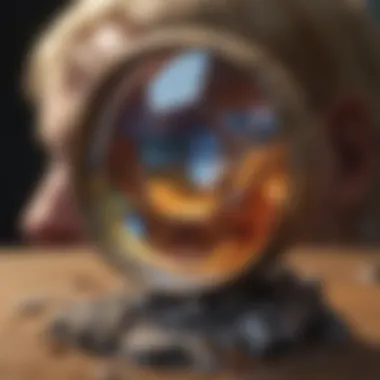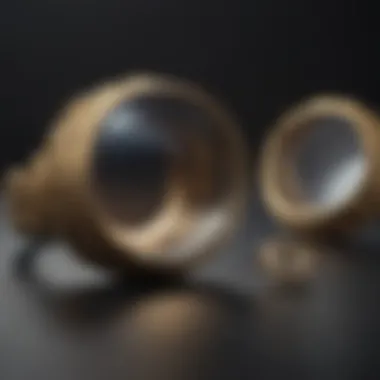Magnifying Lenses: Essential Tools for Jewelry Lovers


Intro
In the intricate world of jewelry, the finer details often hold the most significance. Magnifying lenses emerge as indispensable tools for those who wish to dive deeper into the nuances of their cherished pieces. Whether you’re a seasoned collector wanting to scrutinize the craftsmanship of a vintage brooch or a newcomer intrigued by the glimmering charm of a diamond ring, understanding how to utilize these lenses can elevate your appreciation to another level.
This article sheds light on the various kinds of magnifying lenses available and their unique applications in inspecting jewelry. It aims to equip collectors and enthusiasts alike with the knowledge needed to choose the right tools and to make the most of them in their jewelry appraisal processes. Furthermore, it addresses how to care for these lenses to ensure they serve their purpose efficiently. As we embark on this journey, we'll explore the ways these tools can transform your viewing experience and deepen your connection to the artistry behind fine jewelry.
Prelims to Magnifying Lenses in Jewelry
In the world of jewelry appreciation, magnifying lenses play a pivotal role that often goes unnoticed by the casual observer. These lenses unlock a universe of details that lay hidden to the naked eye, allowing enthusiasts and collectors to gain a deeper understanding and appreciation for the pieces they admire. With the right lens, the intricate craftsmanship, the brilliance of the stones, and the unique qualities of materials all come to life.
Understanding magnification isn't just about enhancing visuals; it's about connecting with the story behind each piece. A simple ring may reveal the meticulous engravings done by a skilled artisan. A gemstone that looks perfectly cut from afar might show subtle inclusions under magnification, leading to a more nuanced evaluation. Considering the different types of lenses available can help collectors make informed choices, as each type serves distinct purposes in jewelry inspection.
Understanding Magnification
Magnification is the process of enlarging the appearance of an object, and in the context of jewelry, it holds significant value. By using a magnifying lens, one can see details that would otherwise remain obscured. This can range from surface textures to intricate design elements, making it a vital tool for both assessing and appreciating jewelry.
When looking at a gemstone, for example, magnification can reveal its clarity and brilliance, impacting its overall value. The beauty of jewelry is often found in its details, and magnifying lenses allow that beauty to shine through.
The Importance of Magnification in Jewelry
The importance of magnification in jewelry cannot be overstated. Here are some key points to consider:
- Quality Assessment: High-quality jewelry is often defined by craftsmanship and precision. Magnification allows collectors to inspect the craftsmanship closely, ensuring there are no hasty defects.
- Material Identification: Understanding what materials your jewelry piece is made from is crucial, especially for buyers invested in authenticity. A magnifier can help identify gemstones or metals and discern between high-quality materials and imitations.
- Flaw Detection: Imperfections, such as chips and scratches, can significantly impact value. Often, these flaws are invisible without magnification.
- Appreciation of Details: Seeing how patterns and fineness play together can evoke a deeper appreciation for the artist's work. Sometimes it's those delicate details that tell the story of a jewel's journey.
The effective use of magnifying lenses provides jewelry enthusiasts with insights that enrich their collecting experiences, transforming simple admiration into informed appreciation. By taking a closer look, one truly grasps the artistry and precision that goes into crafting every piece.
"Jewelry is not just an accessory; it's a piece of history, and magnifying lenses allow us to uncover the chapters that remain hidden."
Thus, investing time in learning about magnifying lenses could significantly elevate the way collectors engage with their treasures.
Types of Magnifying Lenses
When it comes to examining jewelry, knowing the type of magnifying lens can make all the difference. Each type has its own unique features and benefits, tailored for various inspection needs and personal preferences. Understanding the distinctions between these lenses aids both collectors and enthusiasts in making informed decisions about their inspection methods. Let's delve into the most common types of magnifying lenses used in the world of jewelry.
Handheld Magnifiers
Handheld magnifiers are perhaps the most straightforward option. Compact and easy to carry, they come in various sizes and designs. Most often equipped with a simple glass or plastic lens, their magnification capabilities generally range from 2X to 10X. A notable aspect is their versatility; whether inspecting a vintage brooch or examining an intricate necklace, handheld magnifiers provide a direct view without major fuss.
One key benefit is portability. Jewelers and collectors alike appreciate the ability to slip a handheld magnifier into a pocket or purse. However, the downside might be some shakiness during use, as a steady hand is crucial for finer details. This can be problematic when trying to view minute features on gemstones or delicate engravings, so practice might come in handy.
Loupe Magnifiers
Loupe magnifiers possess a more specialized design, often featuring a convex lens that offers superior clarity. They're typically found in 10X magnifications or higher, making them ideal for serious inspections. Jewelers frequently reach for a loupe due to its precision when examining diamonds or intricate metalwork.
An advantage of loupes is that they can be held directly against the eye, freeing up both hands to manipulate the jewelry. This hands-on approach allows you to evaluate craftsmanship closely. However, it can also lead to eye strain if used for prolonged periods. Being adept at using a loupe takes practice, but the rewards in clarity are unmistakable.
A tip for newbies: try to block out surrounding light to see details better!
Headband Magnifiers
With the look of a high-tech tool, headband magnifiers sit comfortably on your head, allowing for a hands-free experience. These devices often come with built-in adjustable LED lights, casting light exactly where you need it. This feature is particularly useful when working on repairs or during meticulous inspections.


The magnification power usually ranges from 1.5X to 3.5X, which is optimal for detailed tasks like soldering or jewelry making. Since they sit firmly on your head, the stability is a great advantage. Yet, they might not be for everyone; some find them clunky or noticeable.
"A clear view is only a headband away!"
Digital Magnifiers
Digital magnifiers represent a modern leap in magnification technology. Offering features that traditional lenses can't match, these devices present images on a screen, often with adjustable magnification levels. They can magnify objects anywhere from 3X to an astounding 120X. This flexibility makes them ideal for collectors with large collections or folks wanting a closer look at components without physical strain.
Digital models often come along with added capabilities like image capture or video output, which can be particularly useful for documentation or when sharing findings with others. Their primary disadvantage tends to be a higher price point compared to their manual counterparts. Also, the reliance on batteries or power can be a bit inconvenient if you wish to inspect pieces on the go.
Applications of Magnifying Lenses in Jewelry
When it comes to the world of jewelry, the details truly matter. Applying magnifying lenses to jewelry inspections unveils layers of intricacy that might escape the naked eye. Not only does this practice enhance the understanding of craftsmanship, but it also plays a vital role in assessing quality, identifying materials, and detecting flaws. Each aspect has implications not just for enthusiasts, but for collectors who have a keen interest in the valuation and authenticity of their treasures.
Assessing Quality and Craftsmanship
Magnifying lenses serve as vital tools for evaluating the quality of jewelry. Quality isn't merely determined by the glitter of a gem; it involves the mastery behind the scenes. By utilizing a loupe, collectors can scrutinize the tiny details in craftsmanship that indicate the skill and effort put into the piece.
For instance, the precision of the settings can reveal much about the maker’s attention to detail. A well-set gemstone, held snugly without gaps, signifies expertise. Conversely, uneven prongs may hint at shoddy workmanship. Thus, wielding a magnifying lens can turn a casual glance into a profound appreciation of the artisan's abilities.
Identifying Material Characteristics
Understanding the materials used in a piece of jewelry can greatly influence its value. Magnifying lenses can help in distinguishing between genuine and synthetic stones. For instance, natural gemstones may possess inclusions or character traits that synthetic versions lack.
With the right lens, one can observe the unique features of a diamond, like its inclusions—those tiny imperfections that make each stone unique. Knowing these characteristics allows collectors to make informed decisions about their purchases, avoiding the pitfalls of imitation stones. This careful scrutiny not only enhances one's collection but also supports a deeper understanding of jewelry as an art form.
Detecting Flaws and Imperfections
Every piece of jewelry tells a story, sometimes revealing hidden flaws, imperfections, or repairs that might not be visible at first sight. Using magnifying lenses, collectors can uncover such narratives. Small scratches or chips might appear insignificant, yet under magnification, they could indicate a history of wear.
Identifying these flaws can play a crucial role in negotiations during purchasing or selling. Knowledge of the piece’s condition can influence its market value. This awareness, gleaned from diligent inspection, can separate a savvy collector from a novice who might overlook these vital details.
Evaluating Settings and Mountings
A piece's mounting is often as important as the gemstone it showcases. Magnifying lenses allow for a thorough examination of the settings, confirming whether they meet the standards for security and aesthetics. For example, the alignment of stones in a multi-stone ring can influence its visual impact and durability.
A properly executed setting keeps stones secure and showcases them beautifully. By inspecting the mountings, a collector can ascertain if the craftsmanship is up to par or if it presents potential issues that could affect the piece’s longevity. This step is crucial for anyone looking to invest in jewelry, especially when considering heirloom pieces that hold sentimental value.
"Magnification doesn't just reveal details; it tells the story of craftsmanship and tradition behind each piece."
Choosing the Right Magnifying Lens
Selecting the appropriate magnifying lens can make a significant difference in your jewelry inspection and appreciation endeavors. It's not merely about having a magnifying tool; rather, it's about finding one that aligns with your specific needs and preferences. The right lens will allow you to delve deeper into the details of your pieces, enhancing your understanding of jewelry craftsmanship, and helping to identify the unique characteristics and artisanship behind each item.
When it comes to choosing a magnifying lens, several factors become pivotal. These include the optical quality, magnification power, and, of course, your personal comfort while using the tool.
Factors to Consider
Before rushing off to purchase a magnifying lens, it’s vital to take a moment and think through a few considerations:
- Usage Purpose: Are you inspecting stones for clarity or assessing the design for overall craftsmanship?
- Frequency of Use: Are you a casual observer or a frequent collector? The regularity of usage will influence what you might want to invest in.
- Budget: Like anything else, magnifiers come in a broad range of prices. Setting a budget can narrow down your options.
- Light Conditions: Consider where you will use the magnifying lens. Will it be at home? Or while attending shows?


Keeping these considerations in mind can steer you in the right direction.
Optical Quality and Glass Types
A magnifying lens is only as good as its glass quality. Flawed or lower-quality glass can distort your view and lead to misunderstanding of your jewelry’s details.
- Optical Glass: This type of glass provides superior clarity. Look for lenses with anti-reflective coatings to minimize glare.
- Plastic Lenses: These are lightweight and shatterproof but may not deliver the same level of clarity as glass.
When examining pieces, you want to see features, inclusions, and reflections without obfuscation. Hence, investing in higher quality glass is generally advisable.
Magnification Power and Field of View
The world of magnification ranges from low to high power, and what you select depends on what you wish to observe.
- Magnification Power: Ranges typically from 2x to 30x. For general inspection, something between 5x and 10x is often sufficient, while more detailed work, especially on intricate settings, may require something stronger.
- Field of View: This refers to how much you can see at one time through the lens. A wider field of view is beneficial for examining larger pieces, while a narrower field may be necessary for focusing on fine details.
In this regard, your preferences as a collector or enthusiast dictate your needs. Think about how you’ll use the lens and what information you want to extract from your jewelry pieces.
"Choosing the right magnifying lens is a key step before delving into the fascinating world of jewelry inspection. The right lens illuminates the unnoticed."
Considering these elements will not only optimize your inspection process but also deepen your appreciation for the art behind jewelry making.
Best Practices for Using Magnifying Lenses
When it comes to inspecting jewelry closely, employing best practices while using magnifying lenses is crucial. These practices not only enhance the viewing experience but also ensure the longevity of the lenses and the items being examined. Proper use of magnifying tools can make a world of difference in how collectors and enthusiasts perceive the intricate details of their prized possessions.
Positioning and Lighting Techniques
Positioning is often an underestimates aspect of utilizing magnifying lenses effectively. Getting the right angle can profoundly impact the clarity of what you see. Ideally, hold the lens at a slight angle to the jewelry piece, which can help in reducing glare. Adjusting the distance between the lens and the object is equally vital. If you get too close, the image becomes blurrier, while being too far means you may miss out on finer details. Finding that sweet spot may take a few tries but is well worth the effort.
Lighting, on the other hand, is a vital component that can alter your entire inspection experience. Using natural light is awesome when you can, as it often reveals colors and patterns much better. But sometimes, you may need to experiment with artificial light. Opt for a well-diffused light source, which can help eliminate unwanted shadows that obscure details. Position the light source at an angle to create depth and make flaws or characteristics stand out.
"Correct lighting can transform the jewelry inspection experience, bringing out colors and details that might remain hidden in shadow."
Some useful pointers include:
- Experiment with two light sources to eliminate shadow.
- Use a jeweler's lamp for adjustable light intensity.
- Try using a solid white backdrop to improve contrast without distracting.
Proper Handling and Care
Treating your magnifying lenses with care is as important as the actual inspection process. If you mishandle them, you risk scratches or other damage that will degrade the quality of your inspections.
First, always handle the lenses by the edges or the frame, avoiding any contact with the glass itself. This simple habit minimizes the chance of fingerprints oiling the lens surface. Furthermore, when not in use, store your lenses in a protective case to shield them from dust, scratches, and impacts.
Cleaning is another critical component of maintenance. Use a soft microfiber cloth specifically designed for eyeglasses or camera lenses. Avoid paper towels or rough fabrics as they can inadvertently scratch the glass. If you notice specks of dirt or oil, slightly dampen the cloth with water or a dedicated lens cleaning solution before wiping.
Regular care not only prolongs the lifespan of your lenses but enhances your inspection capabilities as a collector. By keeping your magnifying lenses in prime condition, you ensure that each examination of jewelry yields the most accurate and delightful results.
Maintaining Magnifying Lenses
Maintaining magnifying lenses is a fundamental yet often overlooked aspect, crucial for those who wish to truly appreciate and inspect jewelry. Just as a jeweler crafts intricate pieces with precision, collectors and enthusiasts must afford their tools the same level of care. Keeping magnifying lenses in optimal condition not only extends their lifespan but ensures that the clarity of vision remains sharp, allowing one to savor every detail of the jewelry under scrutiny.


Cleaning Procedures
The act of cleaning magnifying lenses goes beyond a simple wipe-down. To get the best optical clarity, understanding the right materials and techniques is necessary. Here are some effective steps to follow:
- Use a microfiber cloth: This reduces the likelihood of scratching the lens surface. Paper towels or regular cloths can leave behind fibers or grit.
- Gentle cleaning solutions: Opt for a cleaner specifically designed for glasses or camera lenses. Avoid all-purpose cleaners, as they often contain chemicals that may damage lens coatings.
- Circular motions: When cleaning, use gentle, circular motions to lift debris and smudges without grinding them into the glass.
- Inspect after cleaning: Once cleaned, hold the magnifying lens to the light to ensure no streaks or dust remain.
By implementing these procedures, you provide your magnifying lenses with the care they deserve, allowing your inspections to be as clear and accurate as possible.
Storage Tips
How you store magnifying lenses can significantly impact their longevity and performance. Improper storage can lead to scratches or damage that could impair your ability to inspect jewelry efficiently. Here are some recommendations for keeping your lenses safe and sound:
- Use protective cases: Invest in a dedicated protective case that fits the magnifying lens snugly. This prevents any movement that might lead to impact damage.
- Avoid extreme temperatures: Store in a location where temperature fluctuates minimally, as high heat or extreme cold can affect the lens structure over time.
- Keep them dust-free: Dust can cause a buildup that, over time, decreases optical quality. Use a lens cover or keep them in a closed cabinet to minimize exposure.
- Separate from heavy objects: Avoid placing heavy items on top of the storage area, as this can crush delicate lenses or misalign optical components.
Maintaining magnifying lenses properly is not just a routine; it's an investment in your ability to appreciate fine jewelry deeply.
The Impact of Magnification on Jewelry Appreciation
Understanding how magnification influences jewelry appreciation is crucial for both seasoned collectors and enthusiastic newcomers. Magnifying lenses do not merely serve a practical purpose; they deepen the emotional connection with each piece, transforming a casual glance into a detailed examination of craftsmanship.
Magnification enables a clearer view of the intricate details found in jewelry. A beautifully carved gemstone, intricate setting design, or the unique texture of metal can only be fully appreciated under magnification. Without this tool, such subtleties may go unnoticed, leading to a superficial understanding of the item.
Deepening Understanding of Craftsmanship
Craftsmanship is the soul of jewelry. Each piece tells its own story, rich with traces of the artisan’s skill and care. Using a magnifying lens allows observers to delve into the very fibers of that narrative. For instance, a well-crafted ring can reveal minute facets that indicate a skilled hand;
- The precision of a stone’s cut,
- The artistry of the design,
- The quality of the finishing work,
all become evident when examined closely.
This understanding goes beyond merely identifying quality. It fosters appreciation for the effort and time that jewelers invest into their creations. Observing small features, like the smoothness of solder joints or the consistency of engraving, enriches one’s connection to the piece and its maker.
A notable example can be found in vintage jewelry. Older pieces often exhibit unique engraving and setting techniques no longer used today. By scrutinizing such details through a magnifying lens, collectors gain an invaluable insight into the era's craftsmanship and artistry.
Enhancing Collectors’ Insight
Collectors often seek knowledge and authenticity, and magnifying lenses provide just that. By using these tools, they can go beyond the surface, affording them perspectives that inform their purchasing decisions. Understanding material characteristics, such as clarity in diamonds or color saturation in gemstones, is vital for recognizing true value.
"Jewelry is a reflection of personality and history, and observing its elements closely can unlock hidden depths."
Additionally, thanks to magnification, collectors can spot fake or poorly made pieces. Characteristics typical to counterfeit items, such as irregularities in stone placement or synthetic materials masquerading as genuine ones, become apparent.
Some key insights that magnification brings to collectors include:
- The integrity of settings, ensuring stones are secure,
- Natural imperfections that may add uniqueness,
- Signs of wear that could affect future value.
Ultimately, jewelry appreciation evolves with the use of magnifying lenses. They enable collectors and enthusiasts alike to not merely admire pieces from afar but to engage with them on a deeper level. Choosing to look closer, both literally and figuratively, enhances one’s relationship with each jewel - turning a simple accessory into a treasured artifact.
The End
In reflecting on the role of magnifying lenses within the realm of jewelry appreciation, it's clear they serve as an indispensable tool for collectors and enthusiasts alike. As we have explored throughout this article, these lenses do much more than simply enlarge images; they open a gateway to understanding the artistry and craftsmanship behind each piece of jewelry. This detailed inspection can lead to a deeper appreciation of the intricate details, quality of materials, and the overall value of the jewelry in one's collection.
Summary of Main Points
To tie everything together, here are the main takeaways from our discussion:
- Importance of Magnification: Magnifying lenses enhance the visibility of fine details, allowing for a thorough inspection of craftsmanship and flaws.
- Types of Lenses: Various types, including handheld magnifiers, loupes, and digital versions, offer unique advantages suited to different inspection needs.
- Best Practices: Proper techniques in positioning, lighting, and caring for lenses maximize their effectiveness and lifespan.
- Impact on Appreciation: Using these tools not only aids in the evaluation of jewelry but also enriches the collector's experience, fostering a more profound understanding of artistry.
Encouragement for Further Exploration
As you continue your journey in jewelry appreciation, don’t shy away from experimenting with various magnifying lenses. The world of jewelry is vast and intricate, and the insights gained from using magnifying tools will surely deepen your knowledge and enhance your collecting experience. You may also find interesting discussions in online communities, such as those on reddit.com or specialized jewelry forums, where enthusiasts share their experiences and tips on achieving the best results when inspecting pieces. Engaging in these conversations can further cultivate your understanding and appreciation of the unique characteristics that define fine jewelry.







